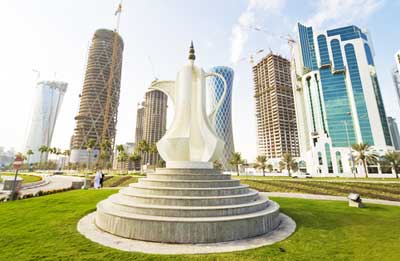
Qatar's fiscal surplus doubles to $27.4bn
Doha, October 2, 2013
Qatar's fiscal surplus more than doubled to a record $27.4 billion - equivalent to about 14.2 per cent of GDP - during the financial year 2012/13, driven by burgeoning oil and gas revenues, said a report.
However, a pick up in infrastructure projects is likely to narrow the fiscal surplus to 9 per cent GDP in the current fiscal year, according to National Bank of Kuwait. The country has posted a surplus every year since FY1999/2000, it stated.
"While total revenues surged 24.7 per cent over the previous year to $76.3 billion, total expenditures grew by only two per cent to $48.9 billion, significantly below the 21 per cent increase in spending recorded the year before and during the last five-years on average," the NBK said in its review.
Significantly, for the first time since 1990, government spending was below budget, with both current and development spending relatively restrained compared to previous years, increasing by only 3.9 per cent y/y to $35.3 billion in the former and declining by 2.5 per cent y/y to $13.5 billion in the latter.
Within current expenditures, the government’s increasing wage bill was reflected in the 14.7 per cent y/y increase in this category, while interest payments and supplies and services declined by 2.5 per cent y/y and 7.0 per cent y/y, respectively.
Meanwhile, the contraction in development spending last year is likely a reflection of the delays experienced in rolling out key capital projects, a situation that should improve this year given the fact that investment activity, as measured by the value of contracts awarded, was up by 30 per cent during the first half and likely to reach $56.5 billion by year-end - double last year’s total.
Given the imperatives of Qatar’s development plan and the 2022 World Cup, development spending is therefore likely to increase from its low of 7.0 per cent of GDP last year to 9.5 per cent of GDP in FY 2013/14, said the NBK report.
On the revenue side, the increase in total revenues by 24.7 per cent to a record $76.3 billion was driven by burgeoning oil and gas revenues, which grew by 10.4 per cent y/y, and, significantly, a substantial increase in income from investments (dividends from government-related entities) and ‘Others’ (corporate taxes, customs duties etc.), which grew by 62.3 per cent y/y and 54.6 per cent y/y, respectively.
However, given that real hydrocarbon output has likely peaked for the time being and upward movements in hydrocarbon prices are not expected, revenue growth will be increasingly dependent on income from non-hydrocarbon activities, it added.
Earlier in the year, the authorities announced an expansionary budget for FY2013/14 in which total spending was likely to increase by 18 per cent on the previous year to $57.9 billion and total revenues by 5.7 per cent to $60 billion.
The government also forecast increasing its development spending by 20.6 per cent, the Kuwaiti lender stated.
Having come under budget last year, spending growth - led by development spending on capital projects - is therefore likely to exceed budget estimates and outpace revenue growth going forward, with the result that the fiscal balance will narrow over the next two years, to 9 per cent and 5 per cent of GDP, respectively.
Despite further increases in spending, fiscal sustainability is nevertheless on the regional policymaking agenda. The Qatari authorities are expected to work towards fulfilling their expressed commitment to contain rising expenditure pressures and balance the budget entirely from non-hydrocarbon revenues by 2020.
According to NBK, the headline inflation in Qatar, as measured by the consumer price index (CPI), has been falling over the last four months, to 2.8 per cent y/y in August.
This is largely due to stabilization in food prices - the government was discounting prices during Ramadan - and deflation in the ‘Miscellaneous goods and services’ category.
However, the inflation in residential rents - the most influential component of the index with 32.2 per cent of the weighting - has been rising steadily since the middle of last year, reaching a high of 6.7 per cent in June.
Buoyant demand, driven by population growth, coupled with tight supply of residential units has put pressure on rents. Inflation in the ‘Entertainment, recreation and culture’ category, however, has been most pronounced so far in 2013, and is at 8.4 per cent y/y in August.
In its comments, NBK said the strong population and economic growth in Qatar would continue to underpin its inflation forecast of 3.4 per cent and 4.1 per cent (year-average) for 2013 and 2014, respectively.
"Qatar’s population was fast approaching the 2 million mark, having increased by 6.2 per cent y/y in 2013 according to mid-year estimates published by the QSA," it stated..
"The labour force, in which expatriates comprise 94 per cent, has also increased, by 9 per cent to 1.47 million persons as Qatar’s rapid economic expansion in recent years has led to an influx of expatriate labor especially in the construction and services sectors. This will likely continue as the government rolls out its development plan," it said.
With LNG output having peaked, Qatar's economic growth is increasingly going to be driven by expansion in the non-hydrocarbon sector. That sector grew 6.2 per cent in real terms in 2012 and is slated to maintain that pace this year and beyond, said the NBK report.
The implementation of Qatar’s National Development Strategy (2011-16), which envisages at least $150 billion in state infrastructure investments, should have further positive spill-over effects on the private sector and the wider domestic economy, it added.-TradeArabia News Service







